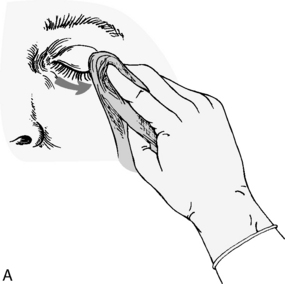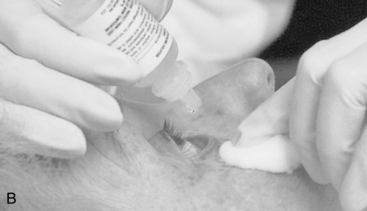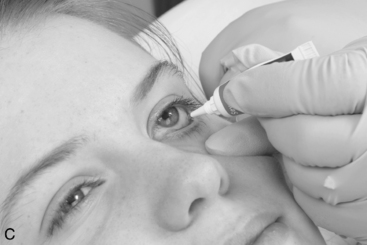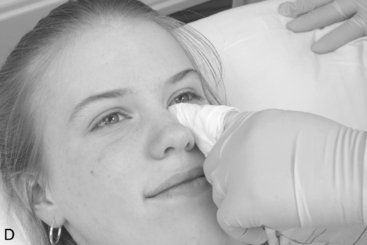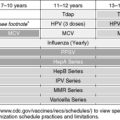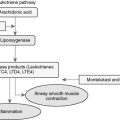CHAPTER 26 Nonprescription Products
I. Introduction
A. Nonprescription or over-the-counter (OTC) products are medicines that can be bought without a prescription. They are relatively safe and effective when directions on the label are followed and when used as the prescriber or health care professional directs.
D. There are more than 80 therapeutic categories of OTC drugs, ranging from acne drug products to weight-control drug products.
II. Cough and Cold
A. The common cold may involve the nose, throat, sinuses, eustachian tubes (connects the ears to the throat), trachea (windpipe), larynx (voice box), and bronchial tubes (airways).
B. The cause of developing a cold is due to a viral infection, including rhinoviruses (most common), coronaviruses, adenoviruses, echoviruses, respiratory syncytial viruses (RSV), and coxsackieviruses.
C. In response to infection, the immune system triggers a series of events, including release of inflammatory cytokines (a group of proteins that help regulate inflammation, blood cell production, and immunity), such as interleukin-6 (IL-6), interleukin-8 (IL-8), and granulocyte-macrophage colony-stimulating factor (GM-CSF), fluid leakage (runny nose), mucous membrane swelling (stuffy nose), increased mucous production, and stimulation of sneeze and cough reflexes.
1. Symptoms usually appear about 1 to 3 days after exposure to a cold virus. Nasal symptoms can begin as early as 2 hours after exposure; cough and sore throat symptoms usually begin 10–12 hours after exposure to the virus.
F. Pharmacological therapy
1. Pain relievers and fever reducers
2. Decongestants help open swollen mucous membranes of the nasal passages so the individual can breathe easier.
c) Examples
(1) Oral decongestant pseudoephedrine (e.g., Sudafed)
d) Side effects
g) Counseling points
(1) Over time, decongestant nose drops, inhalers, and sprays can actually cause rebound congestion, which means the nasal passages are not able to function normally without using these medications.
3. Antihistamines
a) Indications: symptoms like runny or stuffy nose, itchy or sore throat, sneezing, and itchy, watery eyes
4. Cough syrups
b) Examples (Figure 26-1)
III. Otics
A. Otic preparations (ear drops) are commonly used in adults and children and may be used to relieve pain, itching, and inflammation in the ear caused by ear infections, for example. Otic preparations can also be used to remove cerumen (ear wax) and to clear water from the clogged ear (ear drying aid).
H. Counseling points
1. It is best to warm the ear drops to body temperature (37 °C or 98.6 °F) by holding the bottle in the hand for a few minutes and gently rolling the bottle before using the medicine. This helps to lessen the pain in the ear.
3. The earlobe is gently pulled up and back for adults (down and back for children) to straighten the ear canal.
4. The medicine is then dropped into the ear canal as directed, keeping the ear facing up for approximately 5 minutes to allow the medicine to coat the ear canal.
6. Keep the medicine as germ-free as possible, do not touch the dropper to any surface (including the ear), and keep the container tightly closed.
7. To help clear up the infection completely, the patient should keep using this medicine for the full time of treatment, even if the symptoms have disappeared, and do not miss doses.
IV. Ophthalmics
A. Ophthalmic products include eye drops and lubricants. They are commonly used to relieve redness, dryness, itching, and inflammation in the eye caused by seasonal allergies or from working in front of a computer, to name a few examples. Some ophthalmic products can also be used to rinse the eye of debris.
D. Lubricants
1. Indication: For the temporary relief of burning, irritation, and discomfort due to dryness of the eye or exposure to wind or sun
4. Counseling points
a) In treating dry eye, the first thing to do is to remove or reduce the cause. Reducing contact lens wear time and taking breaks from intense visual work are two examples.
V. Pain and Fever
A. Fever
C. Pharmacological therapy may include:
2. Aspirin (Ecotrin, Bayer, Aspergum, Aspirtab, Easprin, Ecpirin)
VI. Sleep Aids and Stimulants
VII. First Aid
A. Burn first aid
1. To care for a burn victim with a first- or second-degree burn, first remove the burning agent to keep it from inflicting further damage.
2. It is important to note that all third-degree burns and complicated location burns, such as the airway and eyes, need immediate evaluation by a doctor, and burnt clothing and/or burning agents should not be removed without the supervision of a healthcare provider.
3. It is recommended by healthcare professionals not to use butter or oils on a burn. The affected area should be doused with cool water as soon as possible.
5. It is recommended by healthcare professionals to not apply ice or cool to near-freezing temperatures; this can cause additional tissue injury.
6. First-degree thermal burns can be treated with local skin care such as aloe vera. Many topical antibiotics (such as Neosporin or Bacitracin) and antiseptics are available.
B. Wound antiseptics and antibiotics
3. After cleaning the wound, apply a thin layer of an antibiotic cream or ointment such as Neosporin or Polysporin to help keep the surface moist.
VIII. Topical Agents for Common Skin Conditions
A. Acne
B. Skin rashes
1. Oral and topical antihistamines like diphenhydramine (Benadryl) have been used to treat skin rashes caused by an allergic reaction.
2. Baking soda
C. Itching
1. Hydrocortisone cream has been applied to the affected area to temporarily relieve itching associated with allergic reactions and exposure to poisonous plants.
E. Poison ivy
2. Baking soda
IX. Antihistamines
A. Indications: symptoms like runny or stuffy nose, itchy or sore throat, sneezing, itchy, watery eyes
X. Constipation, Diarrhea, Nausea, Vomiting
A. Antidiarrheals
3. Antisecretory agent
a) Enzymes (lactase)
B. Laxatives
1. Bulking agents
7. Stool softeners
10. Nonpharmacologic
c) Dietary measures such as increasing fiber (20–35 g each day including more fruits and uncooked vegetables), more water, and more whole grain breads and cereals are helpful.
d) For individuals who get gas or bloating from whole grains, a fiber substitute such as psyllium (a natural soluble fiber) may help. If gas is still a problem, methylcellulose (Citrucel) or polycarbophil (FiberCon) may be beneficial. These products do not undergo bacterial fermentation, therefore creating less gas.
XI. Smoking Cessation
A. There is evidence that combining the nicotine patch with nicotine gum or nicotine nasal spray increases long-term quit rates compared with using a single type of nicotine replacement therapy. Nicotine gum, in combination with nicotine patch therapy, may also reduce withdrawal symptoms better than either medication alone. A doctor or pharmacist can provide more information.
B. Pharmacological therapy
1. Nicotine gum
2. Nicotine lozenge
a) Nicotine lozenge comes in the form of a hard candy and releases nicotine as it slowly dissolves in the mouth. Eventually, the quitter uses fewer and fewer lozenges during the 12-week program until he or she is completely nicotine-free.
c) Counseling points
(1) There is no eating or drinking within 15 minutes before using or while the lozenge is in the mouth.
(2) Each lozenge will last about 20–30 minutes, and nicotine will continue to leach through the lining of the mouth for a short time after the lozenge has disappeared.
3. Nicotine patches
a) Nicotine patch looks like an oversized adhesive bandage. The outer part of the patch sticks to the skin, while the inner portion presses against and slowly releases nicotine into the skin.
c) Counseling points
(1) The patch is used on a clean, dry, nonhairy area of skin on the upper body or the outer part of the arm.
(2) Skin that is very oily, burned, broken out, cut or irritated in any way may cause the patch not to stick.
(3) Men with excess hair can apply the patches on the underside of the arms or clip excess hair from the back or chest.
(7) There are instructions in the package regarding opening, such as where to cut the package so as not to cut the patch.
(8) After opening the package, the patch is immediately applied to the skin, pressing firmly against the skin with the palm for about 10 seconds.
(11) The nicotine patch may not be a good choice for individuals with skin problems or allergies to adhesive tape.
(13) Leaving a patch on for 24 hours may cause sleep disturbance, such as difficulty sleeping or vivid dreams.
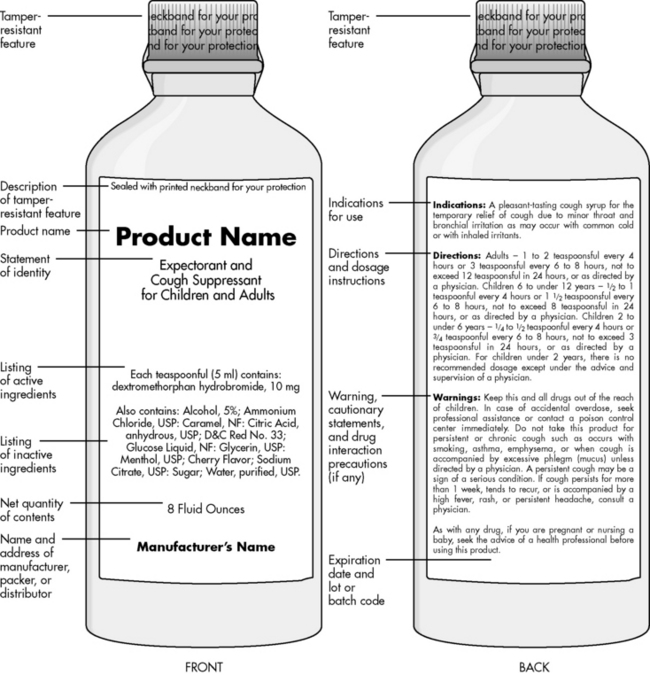
Figure 26-1 Sample front and back of cough expectorant product.
(From Donjon RP, Goeckner BJ: Mosby?s OTC drugs: an over-the-counter drug resource for health professionals. St. Louis, 1999, Mosby.)
PATIENT PROFILE
Pharmacy Consult: BH is seriously trying to lose weight after several failed efforts with diet and exercise alone. She would like more information regarding orlistat (Alli). She recently had an appointment with a registered dietician at the hospital where she works as a nurse and joined a Weight Watchers support group. The dietician encouraged her to consider Alli treatment as an adjunct to diet and exercise.
PATIENT PROFILE QUESTIONS
3. BH confers with her doctor, who agrees that a trial of Alli, combined with current weight loss strategies, is warranted, rather than expose BH to potentially intolerable prescription strength doses of orlistat (Xenical). What are important counseling points for BH before taking Alli?
I. Gastrointestinal side effects include loose or frequent stools that may be hard to control, an urgent need to go to the bathroom, and flatulence that may cause oily spotting.
II. Side effects should diminish with time but may recur if the patient is not compliant with a reduced fat intake in the diet.
III. Take one Alli capsule three times per day with each main meal containing fat. If a meal is skipped, that dose of Alli should also be skipped.
REVIEW QUESTIONS
(Answers and Rationales on page 381.)
1. Which of the following is the preferred form of iron for the treatment of iron deficiency anemia?
3. True or False: Clotrimazole is available for administration as an oral troche, topical cream, topical solution, and vaginal cream.

